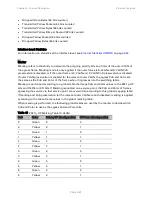
Chapter 4: Feature Description
Ethernet Features
The queue size is defined by the WRED profile that is associated with the queue. For more details,
see
WRED
The Weighted Random Early Detection (WRED) mechanism can increase capacity utilization of TCP
traffic by eliminating the phenomenon of global synchronization. Global synchronization occurs
when TCP flows sharing bottleneck conditions receive loss indications at around the same time.
This can result in periods during which link bandwidth utilization drops significantly as a
consequence of simultaneous falling to a ”slow start” of all the TCP flows. The following figure
demonstrates the behavior of two TCP flows over time without WRED.
Figure 59 Synchronized Packet Loss
WRED eliminates the occurrence of traffic congestion peaks by restraining the transmission rate of
the TCP flows. Each queue occupancy level is monitored by the WRED mechanism and randomly
selected frames are dropped before the queue becomes overcrowded. Each TCP flow recognizes a
frame loss and restrains its transmission rate (basically by reducing the window size). Since the
frames are dropped randomly, statistically each time another flow has to restrain its transmission
rate as a result of frame loss (before the real congestion occurs). In this way, the overall
aggregated load on the radio link remains stable while the transmission rate of each individual
flow continues to fluctuate similarly. The following figure demonstrates the transmission rate of
two TCP flows and the aggregated load over time when WRED is enabled.
Figure 60 Random Packet Loss with Increased Capacity Utilization Using WRED
Page 4-70
















































